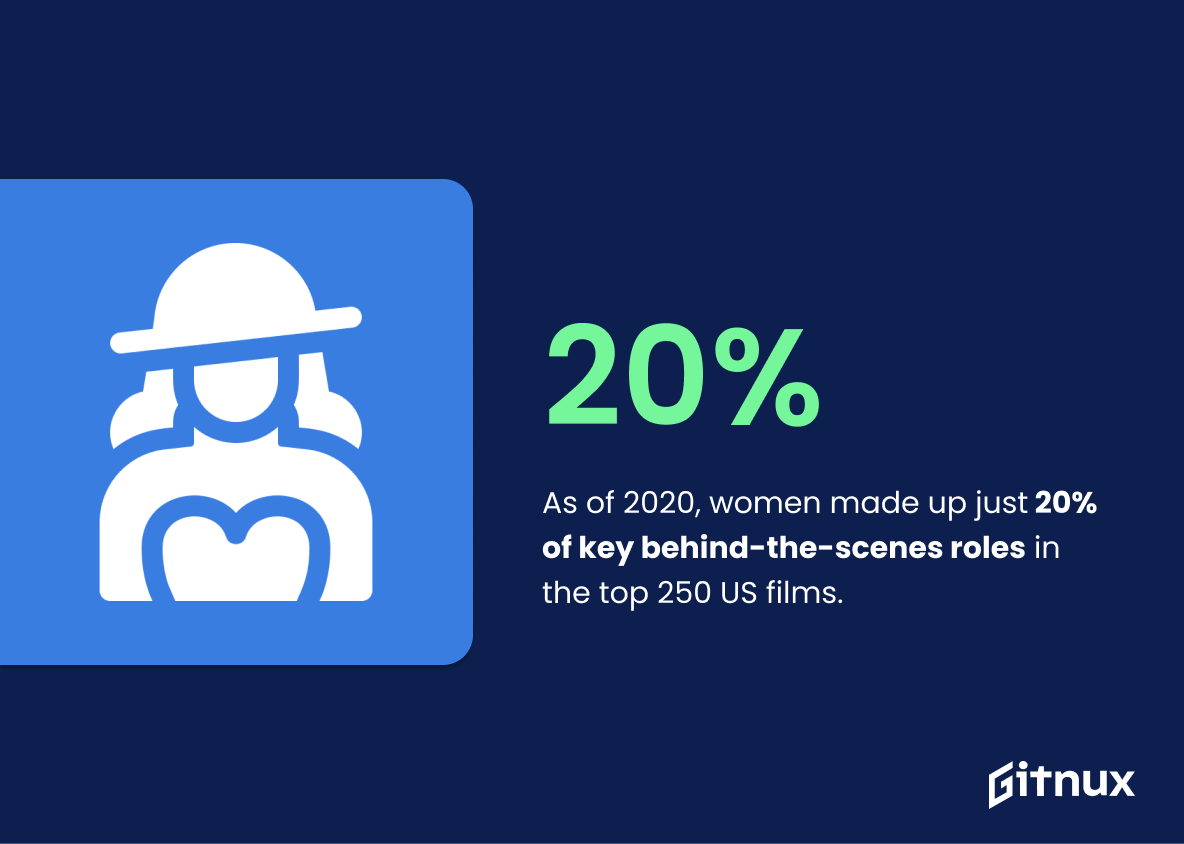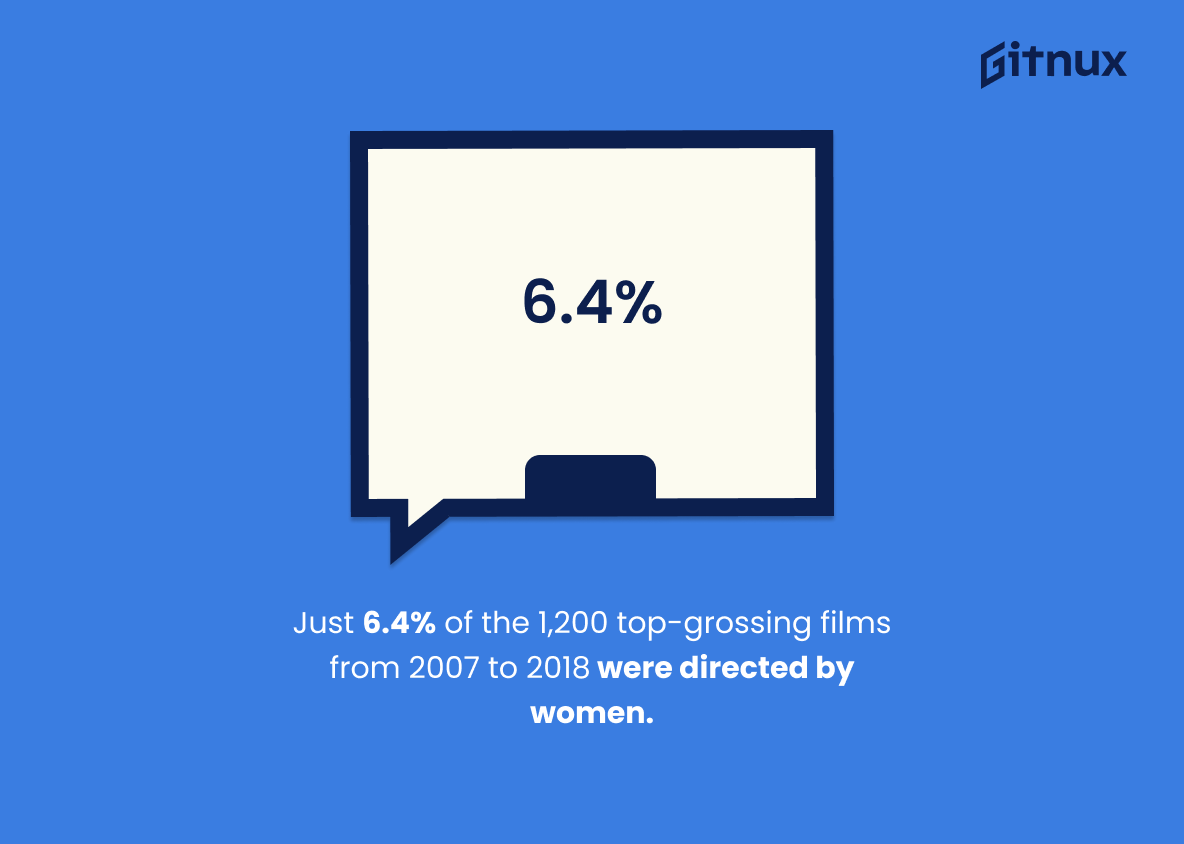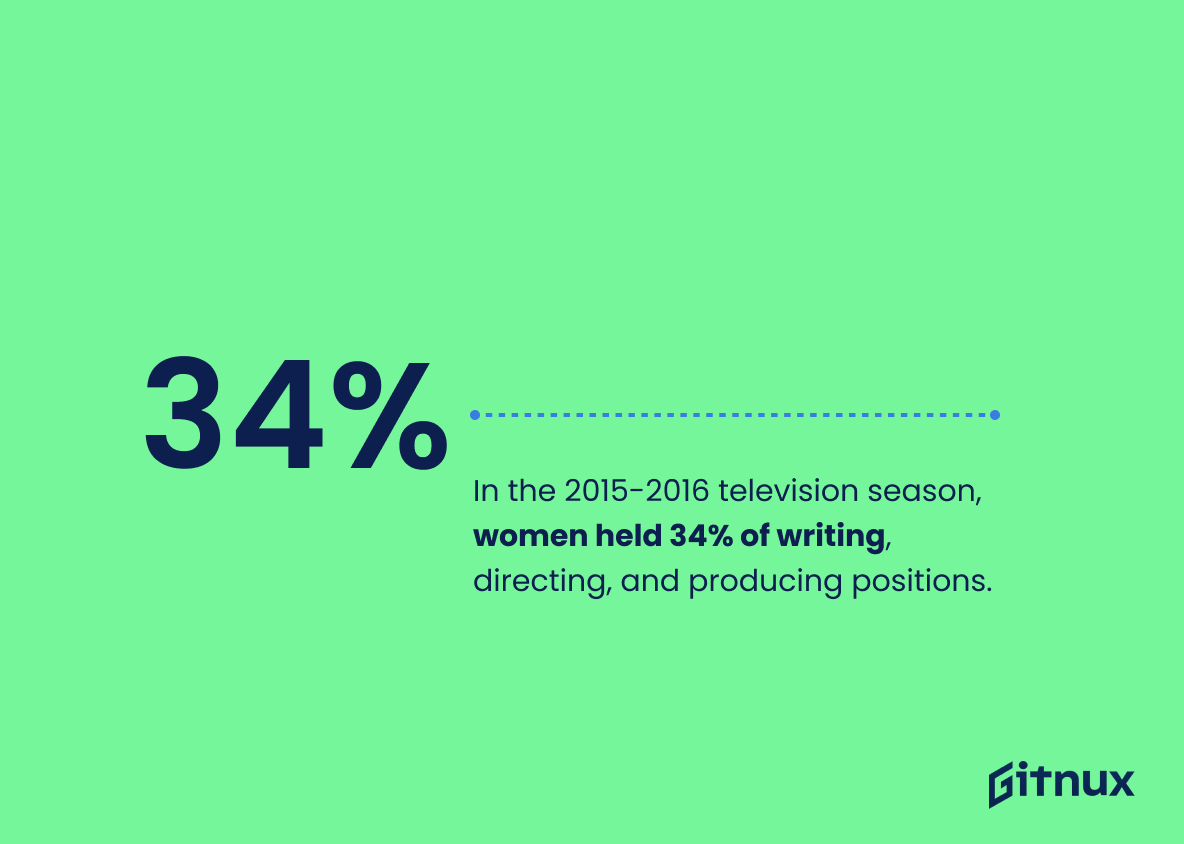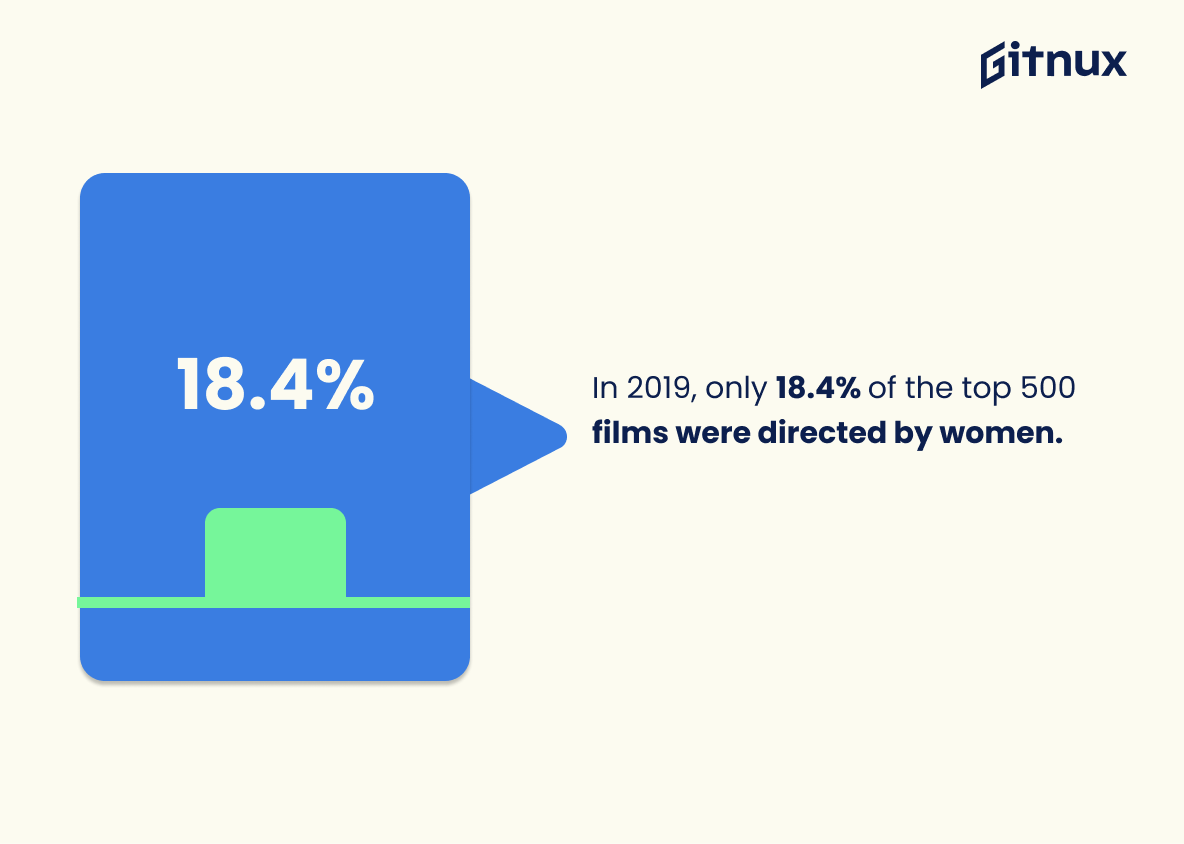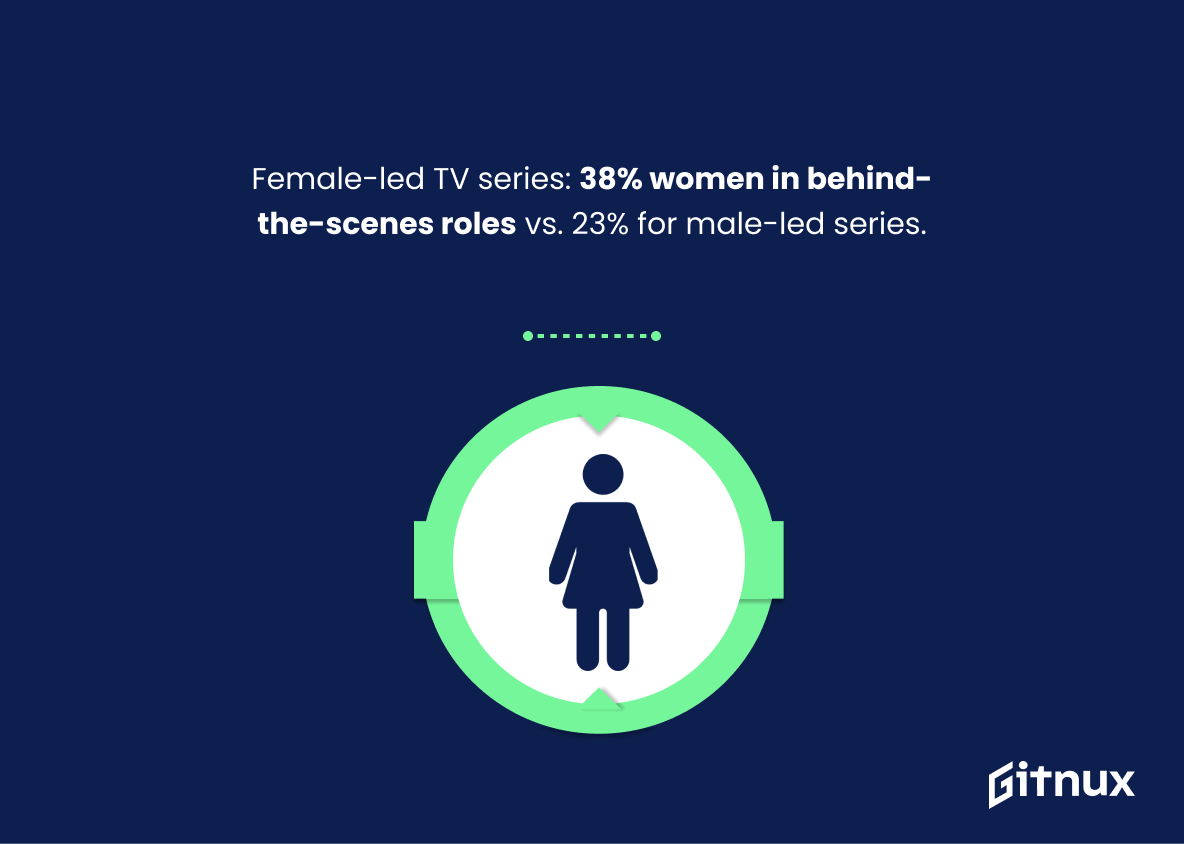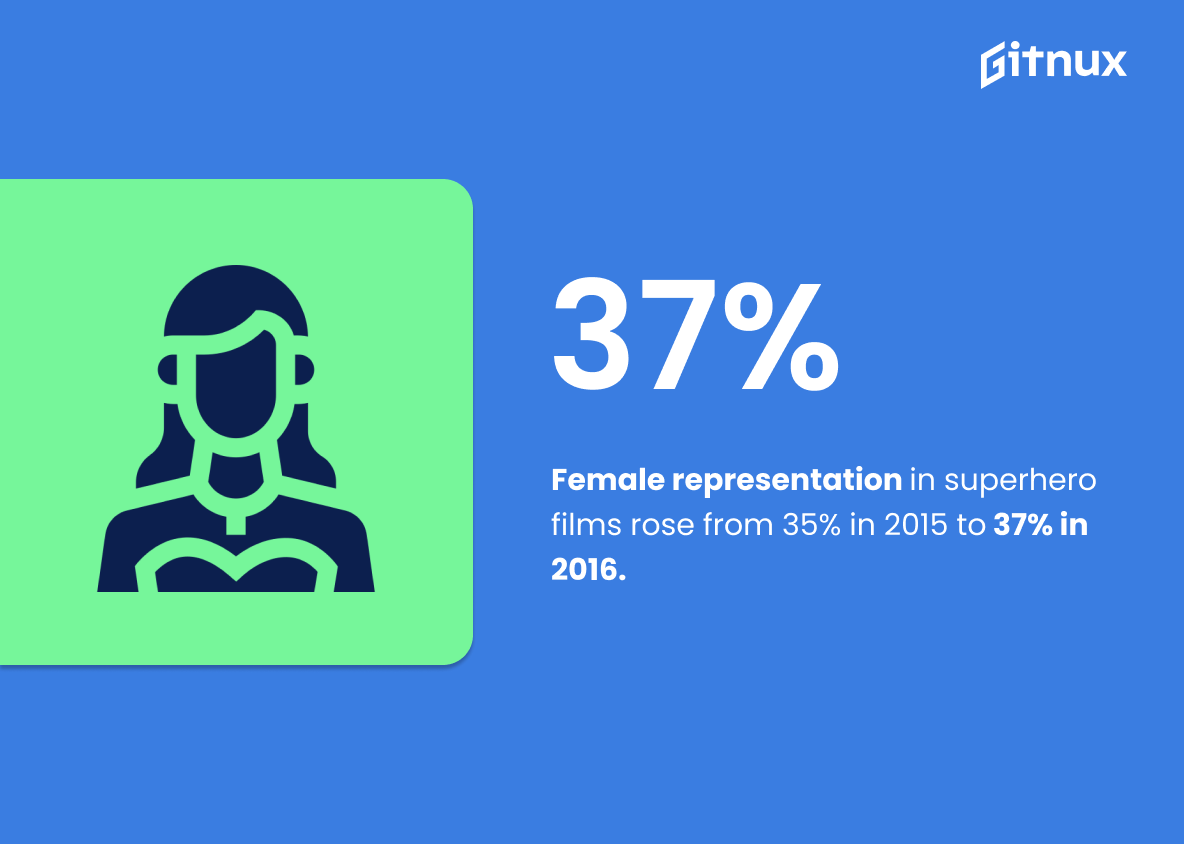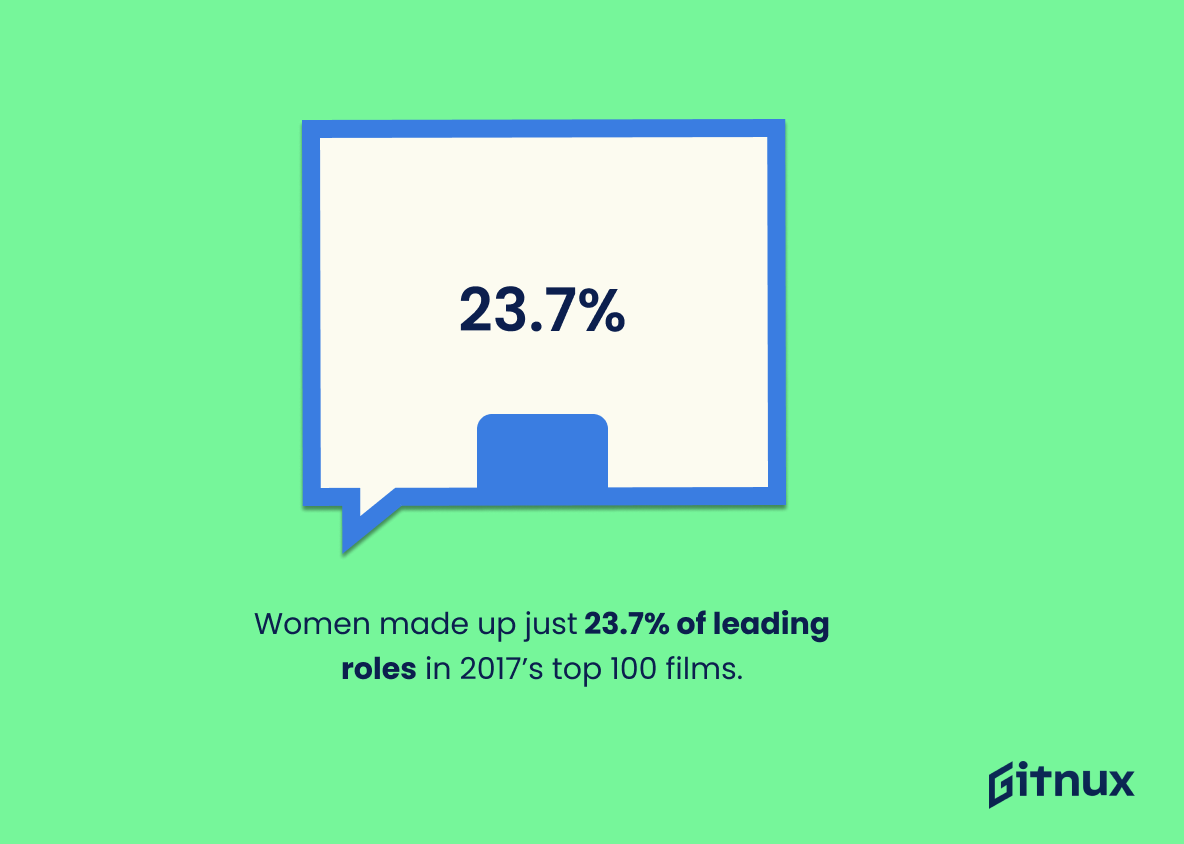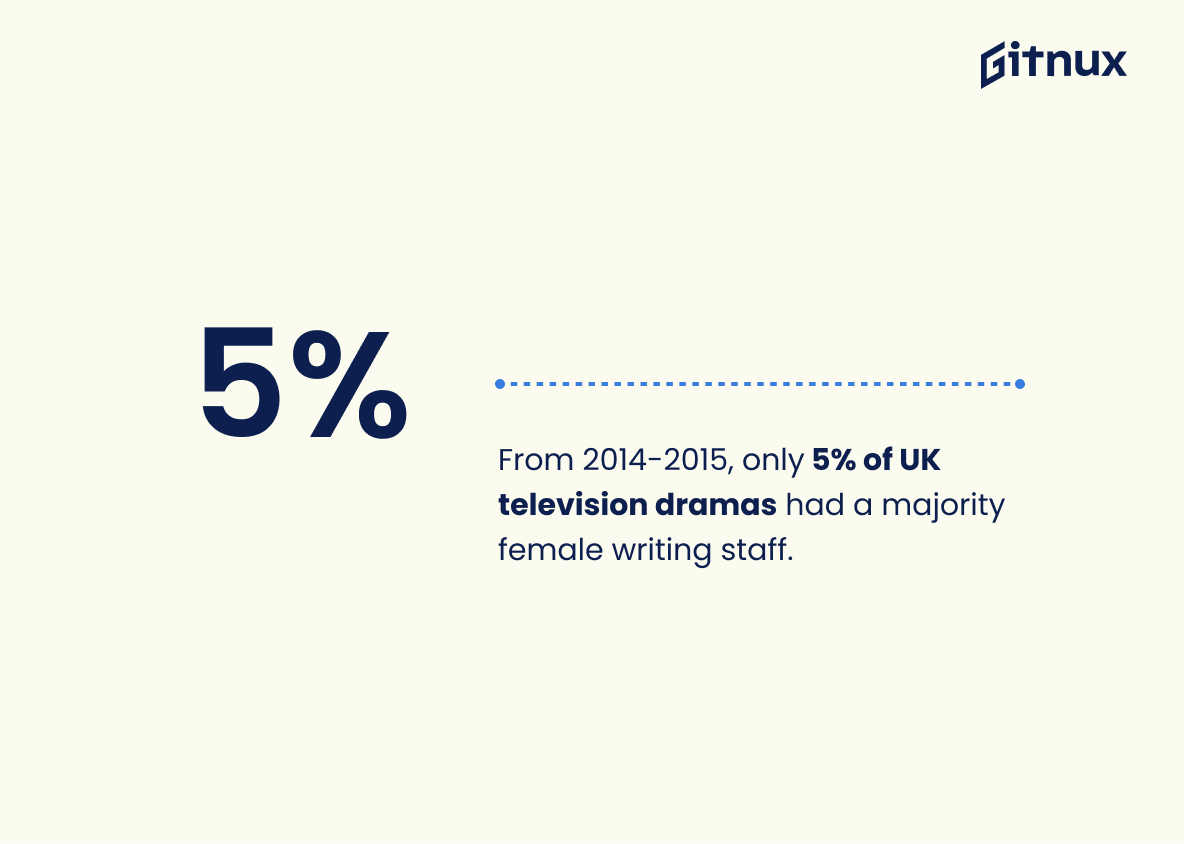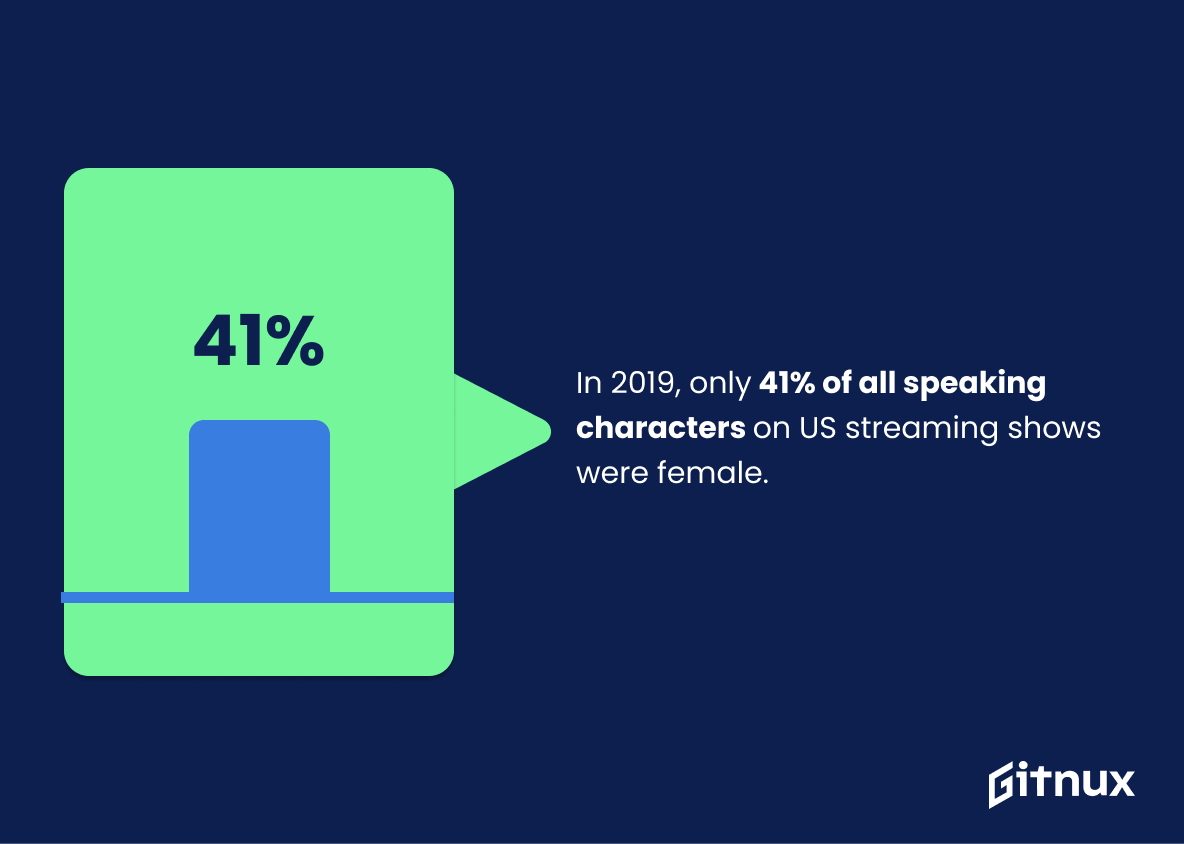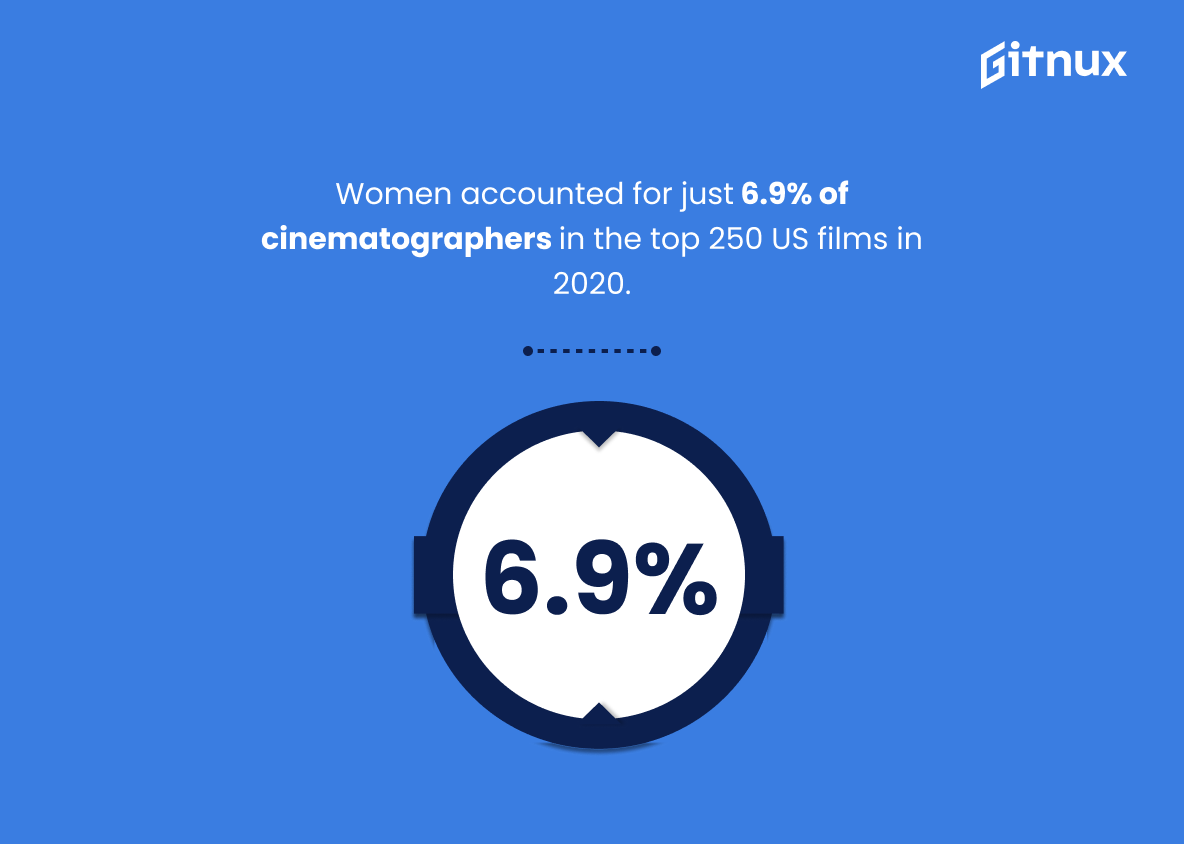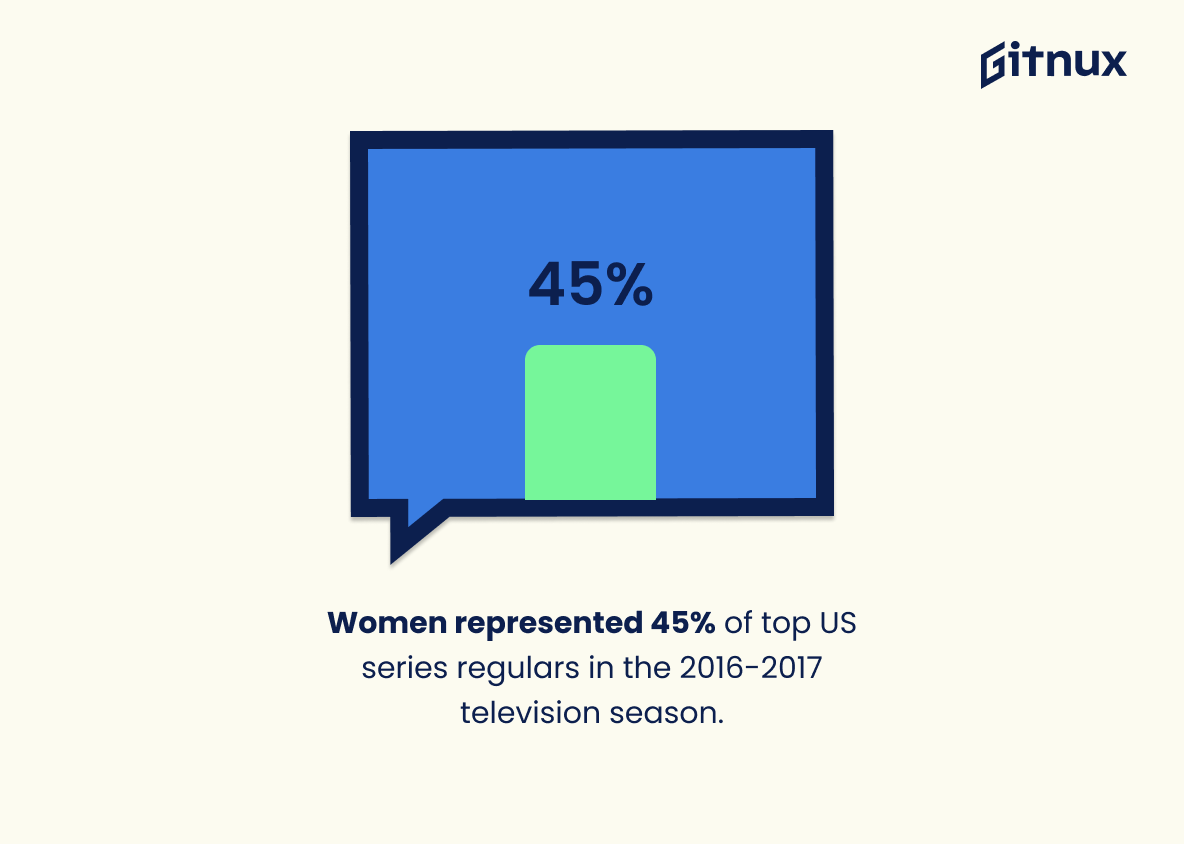The statistics on female representation in media are staggering. Women make up only 34% of film speaking roles globally, despite being 50% of the global population. In the UK, this number drops to 31.4%. Behind-the-scenes positions fare even worse: women represented 21.3%, 26.8%, and 26.2% respectively as directors, writers, and producers in 2018’s global films; just 20% held key behind-the scenes roles in 2020’s top 250 US films; 6.4% directed the 1,200 top grossing films from 2007 to 2018; 2 % had a disability or LGBTQ+ status among 2019’s top 100 films characters; and 18 . 4 % were directors for 2019’s 500 highest grossing movies worldwide . Female representation is also lacking when it comes to television series featuring female main characters (38%) compared with those featuring male leads (23%). Even more concerningly , women accounted for just 6 . 9 % of cinematographers in 2020 ‘ s top 250 US Films ; 22 % wrote UK TV dramas between 2013 – 2016 ; 45 % were regulars on US shows during 2016 – 2017 season ; 27 . 5 percent wore sexually revealing clothing versus 12 . 1 percent males , according to one study — all indicative that there is still much work left undone towards achieving gender parity across media platforms today
This statistic is a stark reminder of the gender disparity that exists in the media industry. It highlights the fact that women are not being given the same opportunities as men to have their voices heard in film, despite making up half of the global population. This statistic is an important indicator of the need for greater female representation in media, and serves as a call to action for those in the industry to create more equitable opportunities for women.
In 2018, women represented 21.3% of directors, 26.8% of writers, and 26.2% of producers of global films.
This statistic is a stark reminder of the gender disparity that exists in the media industry. It highlights the fact that women are still significantly underrepresented in the roles of directors, writers, and producers of global films. This is an issue that needs to be addressed, as it perpetuates the idea that women are not capable of taking on these roles and that their voices are not being heard. This statistic is a call to action to create more opportunities for women in the media industry and to ensure that their stories are being told.
Female Representation In Media Statistics Overview
As of 2020, women made up just 20% of key behind-the-scenes roles in the top 250 US films.
This statistic is a stark reminder of the lack of female representation in the media industry. It highlights the fact that women are still significantly underrepresented in key behind-the-scenes roles in the top 250 US films, despite the fact that women make up half of the population. This statistic is a powerful indicator of the need for greater gender equality in the media industry, and serves as a call to action for those who are passionate about promoting female representation in the media.
Just 6.4% of the 1,200 top-grossing films from 2007 to 2018 were directed by women.
This statistic is a stark reminder of the lack of female representation in the media. It highlights the fact that women are still vastly underrepresented in the film industry, and that there is still a long way to go before gender equality is achieved. This statistic is a call to action for the industry to make a concerted effort to create more opportunities for female directors and to ensure that their voices are heard.
In the 2015-2016 television season, women held 34% of writing, directing, and producing positions.
This statistic is a powerful indicator of the progress being made in female representation in media. It shows that women are increasingly being given the opportunity to take on leadership roles in the television industry, which is a positive step towards achieving gender equality in the media. This statistic is also important because it highlights the need for further progress in this area, as there is still a significant gap between the number of men and women in these positions. By highlighting this statistic, it can help to raise awareness of the issue and encourage further action to be taken to close the gender gap in the media.
In 2019, only 18.4% of the top 500 films were directed by women.
This statistic is a stark reminder of the lack of female representation in the film industry. It highlights the fact that women are still vastly underrepresented in the top 500 films, despite the fact that women make up half of the population. This statistic is a call to action for the film industry to make a concerted effort to increase female representation in the top 500 films.
In TV series featuring female main characters, women made up 38% of behind-the-scenes roles, compared to 23% of those with male main characters.
This statistic is a powerful indicator of the gender disparity in the media industry. It shows that when it comes to behind-the-scenes roles, women are significantly underrepresented compared to men. This is an important statistic to consider when discussing female representation in media, as it highlights the need for more female voices in the industry.
Female representation in superhero films increased between 2015 and 2016 (35% in 2015 to 37% in 2016).
This statistic is a testament to the progress being made in the fight for gender equality in media. It shows that female representation in superhero films is slowly but surely increasing, and that the industry is taking steps towards a more balanced representation of genders. This is an encouraging sign for those advocating for greater female representation in media, and serves as a reminder that progress is possible.
Women made up just 23.7% of leading roles in 2017’s top 100 films.
This statistic serves as a stark reminder of the lack of female representation in leading roles in the media. It highlights the need for more female characters to be featured in films, and for those characters to be given more meaningful roles. This statistic is an important part of the conversation about female representation in media, and it is a reminder that there is still much work to be done in order to achieve gender equality in the media.
From 2014-2015, only 5% of UK television dramas had a majority female writing staff.
This statistic serves as a stark reminder of the lack of female representation in the writing staff of UK television dramas. It highlights the need for more female writers to be given the opportunity to contribute to the industry, and to have their voices heard. This statistic is an important part of the conversation surrounding female representation in media, as it demonstrates the need for more diversity in the writing staff of television dramas.
In 2019, only 41% of all speaking characters on US streaming shows were female.
This statistic is a stark reminder of the gender imbalance that still exists in the media industry. It highlights the fact that female representation in streaming shows is still significantly lower than that of males, and that there is still a long way to go before gender equality is achieved in the media. This statistic is an important one to consider when discussing female representation in media, as it serves as a reminder of the progress that still needs to be made.
Women accounted for just 6.9% of cinematographers in the top 250 US films in 2020.
This statistic is a stark reminder of the lack of female representation in the film industry. It highlights the fact that women are still significantly underrepresented in the top 250 US films, despite the increasing demand for more diverse and inclusive media. This statistic is a call to action for the industry to make a concerted effort to create more opportunities for female cinematographers and to ensure that their voices are heard.
As of 2018, only 24% of protagonists in the top 100 grossing films were women.
This statistic is a stark reminder of the lack of female representation in the media. It highlights the fact that women are still vastly underrepresented in the top grossing films, and that there is still a long way to go in terms of achieving gender equality in the media. This statistic is an important one to consider when discussing female representation in media, as it serves as a reminder of the need for more female protagonists in films.
Women represented 45% of top US series regulars in the 2016-2017 television season.
This statistic is a powerful reminder of the progress that has been made in terms of female representation in media. It shows that women are increasingly being given the opportunity to take on leading roles in television series, which is a positive step towards achieving gender equality in the entertainment industry. This statistic is an important part of the conversation about female representation in media, and it serves as a reminder that there is still work to be done in order to ensure that women are given the same opportunities as men in the entertainment industry.
Conclusion
The statistics presented in this blog post demonstrate a clear lack of female representation in media. Women make up only 34% of film speaking roles globally, despite being 50% of the global population; just 31.4% of speaking characters in film were female in 2014; women represented 21.3%, 26.8%, and 26.2% respectively as directors, writers, and producers for films released worldwide in 2018; 20% held key behind-the-scenes positions for top 250 US films released that same year; 6.4 %of 1,200 top grossing films from 2007 to 2018 had been directed by women; 2 %of female characters featured on 2019’s top 100 movies had disabilities or LGBTQ+ status ;34 %held writing directing and producing positions during 2015 – 2016 television season while 18 . 4 %directed the 500 highest grossing movies that same year ;38 percent worked behind the scenes when main character was a woman compared to 23 percent with male lead , 35%-37 percentage increase between 2015 &2016 regarding superhero movie females ,21percent held all key behind scene position at usa’s 2019 box office hits ,23 . 7percent leading role among 2017’s best hundred flicks 5percent uk tv drama episodes written by ladies 45 percent series regulars at american shows 2016/2017 season 27 .5 sexually revealing clothing worn by females versus 12 .1 males 2020 stats show cinematographers are mostly men (6 .9%) 22uk tv dramas 2013 /16 penned down by gals All these figures point towards an urgent need for more gender equality within media production across different countries around the world if we want to see real progress made towards achieving true diversity both onscreen and offscreen alike
References
0. – https://www.theguardian.com
1. – https://www.seejane.org
2. – https://www.boxgirls.org
3. – https://www.annenberg.usc.edu
4. – https://www.glaad.org
5. – https://www.equalityhumanrights.com
6. – https://www.wmc.3cdn.net
7. – https://www.nyfa.edu
8. – https://www.weforum.org
9. – https://www.syfy.com
10. – https://www.mckinsey.com
11. – https://www.hollywoodreporter.com
12. – https://www.womenintvfilm.sdsu.edu
